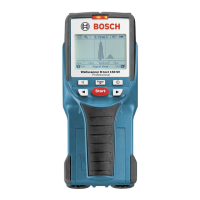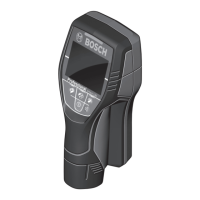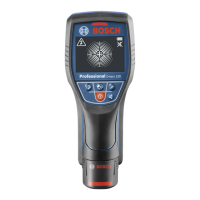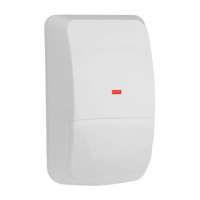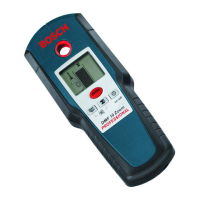English | 21
Bosch Power Tools 1 609 929 R51 | (14.7.09)
Method of Operation (see figure B)
The measuring tool
checks the base materi-
al of sensor area 9 in
measurement direc-
tion A to the displayed
measuring depth.
Measurement is possi-
ble only during move-
ment of the measuring
tool in the direction of
travel B and for a meas-
uring distance of at
least 10 cm. Move the
measuring tool in a straight line with light pres-
sure over the wall so that the wheels remain in
contact with the wall. Objects are detected
that differ from the material of the wall. The
allowable drilling depth and, if possible, the
object material, are indicated on the display.
Optimum results are achieved when the meas-
ured distance is at least 40 cm and the measur-
ing tool is moved slowly over the entire location
to be checked. The tool’s method of operation
ensures reliable detection of outer object edges
that run transverse to the measuring tool’s
movement direction.
Therefore, always move crossways over the
area to be checked.
If several objects are located one over the other
in the wall, the object that is indicated in the dis-
play is the one nearest to the surface.
The representation of the properties of detect-
ed objects in the display 16 can deviate from the
actual object properties. This applies particular-
ly for very thin objects, which are represented
thicker in the display. Large cylindrical objects
(e.g. plastic or water pipes) can appear in the
display smaller than they actually are.
Detectable Objects
– Plastic pipes (e.g. water-carrying plastic
pipes, as used in floor/wall-heating systems,
with at least 10 mm in diameter; empty pipes
with at least 20 mm in diameter)
– Electrical wiring (independent of whether
carrying voltage or not)
– Three-phase mains wiring (e.g. to the stove)
– Low-voltage wiring (e.g. for door bell,
telephone
– Metal pipes, bars, beams of any type
(e.g. steel, copper, aluminium)
– Reinforcing steel
– Wooden beams
– Hollow spaces
Measurements possible
– In brickwork (bricks, porous concrete, foam
concrete, aerated concrete, lime-sand brick)
– In concrete/reinforced concrete
– In light construction walls
– Under surfaces such as stucco, tiles, wall-
paper, parquet flooring, carpet
– Behind wood, gypsum board
Special Measuring Cases
Based on the measuring priniciple, unfavourable
conditions can influence the measuring result,
for example:
– Multi-layered walls
– Empty plastic pipes and wood beams in
hollow spaces and light construction walls
– Objects running inclined in walls
– Metal surfaces and damp areas; in walls,
these can possibly be indicated as an object
(e.g. when the water content is high).
Please observe that concrete requires sever-
al months to dry completely.
– Hollow spaces in a wall; these can be indicat-
ed as objects.
– Closeness to equipment that generates
strong magnetic or electromagnetic fields,
e.g. radio base stations or generators.
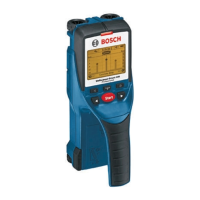
